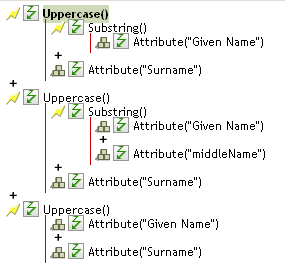Unique Name
Expands to a pattern-based name that is unique in the destination data store according to the criteria specified.
Fields
- Attribute Name
-
Specify the name of attribute to check for uniqueness.
- Scope
-
Specify the scope in which to check uniqueness. The options are subtree or subordinates.
- Start Search
-
Select a starting point for the search. The starting point can be the root of the data store, or be specified by a DN or association.
- Pattern
-
Specify patterns to use to generate unique values by using the Argument Builder.
- Counters Use
-
Select when to use a counter. The options are:
-
Always use a counter
-
Never use a counter
-
After all patterns failed without
-
- Counters Pattern
-
Select which pattern to use the counter with. The options are:
-
Only with first pattern
-
Only with last pattern
-
Use with all patterns
-
- Start
-
The starting value of the counter.
- Digits
-
Specify the width in digits of counter; the default is 1. The option prepends 0 to match the digit length. For example, with a digit width of 3, the initial unique value would be appended with 001, then 002, and so on.
- If Cannot Construct Name
-
Select the action to take if a unique name cannot be constructed. The options are:
-
Ignore, return empty
-
Generate warning, return empty name
-
Generate error, abort current transaction
-
Generate fatal error, shutdown driver
-
Remarks
Each <arg-string> element provides a pattern to be used to create a proposed name.
A proposed name is tested by performing a query for that value in the name attribute against the destination data store using the <arg-dn> element or the <arg-association> element as the base of the query and scope as the scope of the query. If the destination data store is the Identity Vault and name is omitted, then a search is performed against the pseudo-attribute “[Entry].rdn”, which represents the RDN of an object without respect to what the naming attribute might be. If the destination data store is the application, then name is required.
A pattern can be tested with or without a counter as indicated by counter-use and counter-pattern. When a pattern is tested with a counter, the pattern is tested repeatedly with an appended counter until a name is found that does not return any instances or the counter is exhausted. The counter starting value is specified by counter-start and the counter maximum value is specified in terms of the maximum number of digits as specified by counter-digits. If the number of digits is less than those specified, then the counter is right-padded with zeros unless the counter-pad attribute is set to false. The counter is considered exhausted when the counter can no longer be represented by the specified number of digits.
As soon as a proposed name is determined to be unique, the testing of names is stopped and the unique name is returned.
The order of proposed names is tested as follows:
-
Each pattern is tested in the order specified. If counter-use=“always” and the pattern is one of the patterns indicated by the counter-pattern then the pattern is tested with a counter, otherwise it is tested without a counter.
-
If no unique name has been found after the patterns have been exhausted and counter-use=“fallback”, then the patterns indicated by the counter-pattern are retried with a counter.
If all specified combinations of patterns and counters are exhausted, then the action specified by the on-unavailable is taken.
Example

The following is an example of the Editor pane when constructing the unique name argument:

The following pattern was constructed to provide unique names:

If this pattern does not generate a unique name, a digit is appended, incrementing up to the specified number of digits. In this example, nine additional unique names would be generated by the appended digit before an error occurs (pattern1 - pattern99).